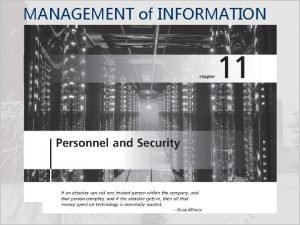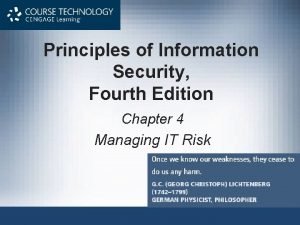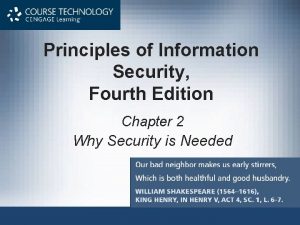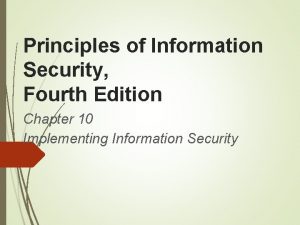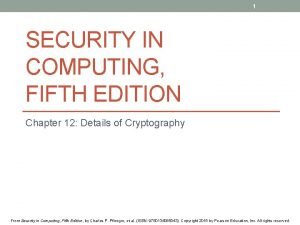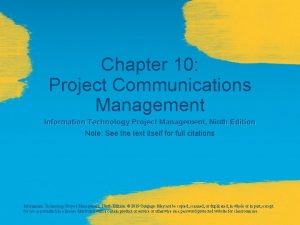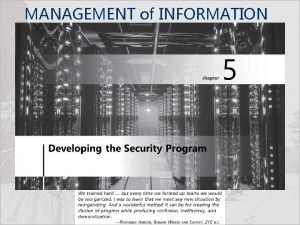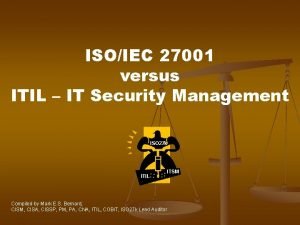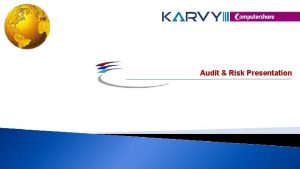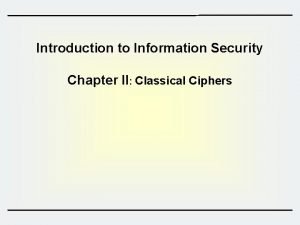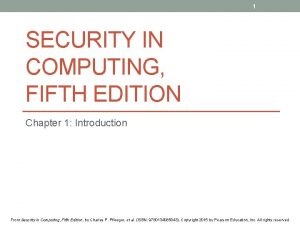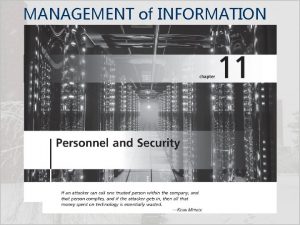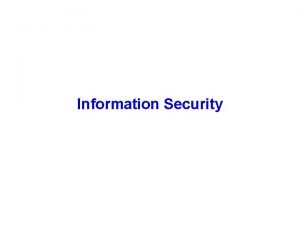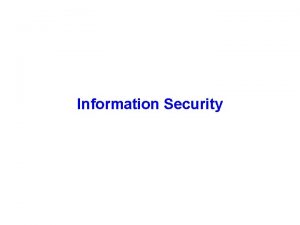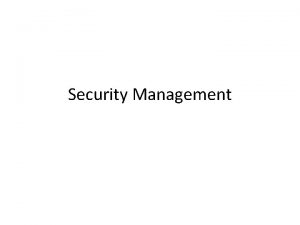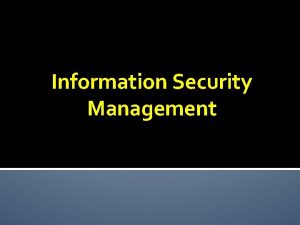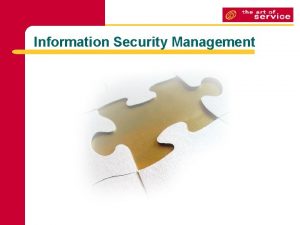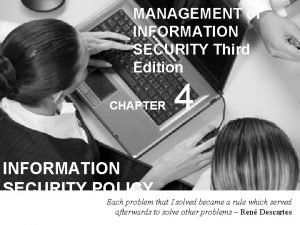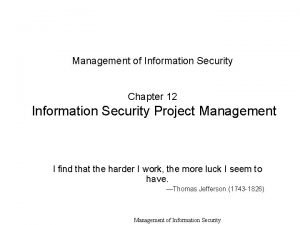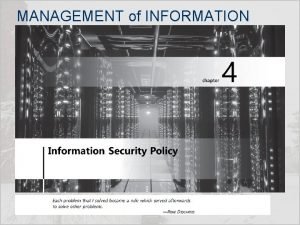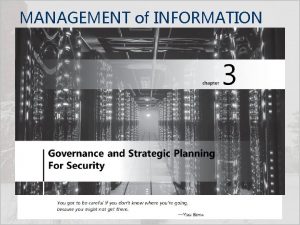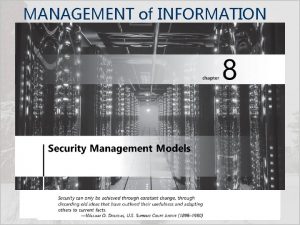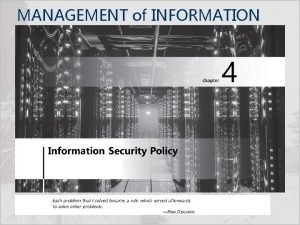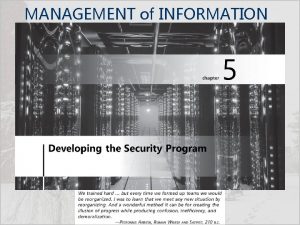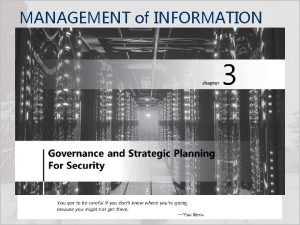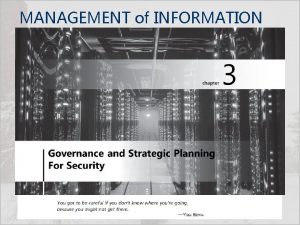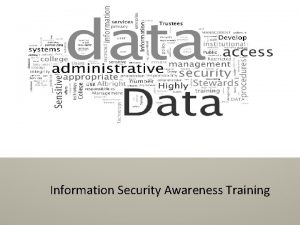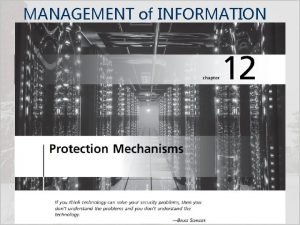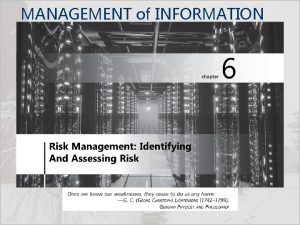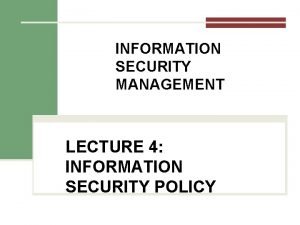Management of Information Security 4 th Edition Chapter



































- Slides: 35

Management of Information Security, 4 th Edition Chapter 9 Risk Management: Controlling Risk

Objectives • Recognize the strategy options used to control risk and be prepared to select from them when given background information • Evaluate risk controls and formulate a cost-benefit analysis (CBA) using existing conceptual frameworks • Explain how to maintain and perpetuate risk controls • Describe popular approaches used in the industry to manage risk Management of Information Security, 4 th Edition © Cengage Learning 2014 2

Risk Control Strategies • Once the Info. Sec development team has created the ranked vulnerability worksheet, the team must choose one of five basic control strategies: – – – Defense Transferal Mitigation Acceptance Termination Management of Information Security, 4 th Edition © Cengage Learning 2014 3

Defense • Defense risk control strategy - attempts to prevent the exploitation of the vulnerability – Accomplished by means of countering threats, removing vulnerabilities in assets, limiting access to assets, and adding protective safeguards – Sometimes referred to as avoidance • Three common methods of risk defense: – Application of policy – Application of training and education – Implementation of technology Management of Information Security, 4 th Edition © Cengage Learning 2014 4

Transferal • Transferal risk control strategy - attempts to shift the risk to other assets, other processes, or other organizations • May be accomplished by: – – – Rethinking how services are offered Revising deployment models Outsourcing to other organizations Purchasing insurance Implementing service contracts with providers Management of Information Security, 4 th Edition © Cengage Learning 2014 5

Mitigation • Mitigation risk control strategy - attempts to reduce the damage caused by a realized incident or disaster – By means of planning and preparation • Includes three types of plans – Incident response (IR) plan – Disaster recovery (DR) plan – Business continuity (BC) plan • Mitigation depends on the ability to detect and respond to an attack as quickly as possible Management of Information Security, 4 th Edition © Cengage Learning 2014 6

Table 9 -1 Summary of mitigation plans Plan Description Example When Deployed Time frame Incident response (IR) plan Actions an organization takes during incidents (attacks) • Preparations for recovery should a disaster occur • Strategies to limit losses before and during a disaster • Step-by-step instructions to regain normalcy Steps to ensure continuation of the overall business when the scale of a disaster exceeds the DRP"s ability to quickly restore operations • List of steps to be taken during disaster • Intelligence gathering • Information analysis • Procedures for the recovery of lost data • Procedures for the reestablishment of lost services • Shutdown procedures to protect systems and data As an incident or disaster unfolds Immediate and real-time reaction immediately after the incident is labeled a disaster Short-term recovery • Preparation steps for activation of secondary data centers • Establishment of a hot site in a remote location Immediately after the disaster is determined to affect the continued operations of the organization Long-term organizational stability Disaster recovery (OR) plan Business continuity (BC) plan Management of Information Security, 4 th Edition © Cengage Learning 2014 7

Acceptance • Acceptance risk control strategy - the decision to do nothing to protect an information asset from risk and accept the outcome • Acceptance is recognized as a valid strategy only when the organization has: – Determined the level of risk posed to the information asset – Assessed the probability of attack and the likelihood of a successful exploitation of a vulnerability – Estimated the potential damage or loss that could result from attacks Management of Information Security, 4 th Edition © Cengage Learning 2014 8

Acceptance (continued) • Acceptance is recognized as a valid strategy only when the organization has (cont’d): – Evaluated potential controls using each appropriate type of feasibility – Performed a thorough CBA – Determined that the costs to control the risk to a particular function, service, collection of data, or information asset do not justify the cost of implementing and maintaining controls • Strategy should be implemented when the cost of protecting an asset does not justify the expense Management of Information Security, 4 th Edition © Cengage Learning 2014 9

Termination • Termination risk control strategy - based on the organization’s need or choice not to protect an asset – The organization does not wish the asset to remain at risk so it is removed form the environment that represents risk • Termination must be a conscious business decision – Not simply the abandonment of an asset • Would technically qualify as acceptance Management of Information Security, 4 th Edition © Cengage Learning 2014 10

Managing Risk Part 1 • Risk appetite - the quantity and nature of risk that organizations are willing to accept – As they evaluate the trade-offs between perfect security and unlimited accessibility – Also known as risk tolerance • The key is for the organization to find balance in its decision-making processes and in its feasibility analyses – Assuring that its risk appetite is based on experience and facts, not on ignorance and wishful thinking Management of Information Security, 4 th Edition © Cengage Learning 2014 11

Managing Risk Part 2 • Residual risk is the amount of risk that remains after the organization has implemented policy, education and training, and technical controls and safeguards • The goal of Info. Sec is not to bring residual risk to zero – It is to bring residual risk in line with an organization’s risk appetite Management of Information Security, 4 th Edition © Cengage Learning 2014 12

Figure 9 -1 Residual risk Management of Information Security, 4 th Edition © Cengage Learning 2014 13

Managing Risk Part 3 • Rules of thumb for selecting a strategy: – When a vulnerability exists in an important asset implement security controls to reduced likelihood of a vulnerability being exploited – When a vulnerability can be exploited - apply layered protections, architectural designs, and administrative controls to minimize risk – When the attacker’s potential gain is greater than the costs of attack - apply protections to increase attacker’s cost – When the potential loss is substantial - apply technical and nontechnical protections to limit the extent of attack Management of Information Security, 4 th Edition © Cengage Learning 2014 14

Figure 9 -2 Risk-handling action points Management of Information Security, 4 th Edition © Cengage Learning 2014 15

Managing Risk Part 4 • Once a control strategy has been selected and implemented – Controls should be monitored and measured on an ongoing basis to determine effectiveness Figure 9 -3 Risk control cycle Management of Information Security, 4 th Edition 16

Feasibility and Cost-Benefit Analysis • Cost avoidance - the money saved by using the defense strategy via the implementation of control – Eliminating the financial ramifications of an incident • Before deciding on a strategy – An organization must explore all readily accessible information about the economic and noneconomic consequences of an exploitation of the vulnerability Management of Information Security, 4 th Edition © Cengage Learning 2014 17

Cost-Benefit Analysis • Economic feasibility - the most common criterion used when evaluating a strategy to implement Info. Sec controls and safeguards • Economic feasibility analysis beings by valuing the information assets and determining the loss in value if those assets become compromised • Cost-benefit analysis (CBA) - A form of feasibility study that compares the life-cycle cost of implementing a control mechanism against the estimated economic benefit that would accrue from the implementation of the control Management of Information Security, 4 th Edition © Cengage Learning 2014 18

Cost • Items that affect the cost of a control or safeguard: – Cost of development or acquisition (hardware, software, and services) – Training fees (cost to train personnel) – Cost of implementation (installing, configuring, and testing hardware, software, and services) – Service costs (vendor fees for maintenance and upgrades) – Cost of maintenance (labor expense to verify and continually test, maintain, train, and update) Management of Information Security, 4 th Edition © Cengage Learning 2014 19

Benefit • Benefit - the value to the organization of using controls to prevent losses associated with a specific vulnerability – Usually determined by valuing the information asset or assets exposed by the vulnerability – Then determining how much of that value is at risk and how much risk exists for the asset – The result is expressed as the annualized loss expectancy (ALE) Management of Information Security, 4 th Edition © Cengage Learning 2014 20

Asset Valuation Part 1 • Asset valuation - the process of assigning financial value or worth to each information asset – Can involve the estimation of real or perceived costs • Costs can be selected from any or all of those associated with the design, development, installation, maintenance, protection, recovery, and defense against loss or litigation • Some costs are easily determined – Cost of replacing a network switch • Other costs are almost impossible to determine – Dollar value loss in market share Management of Information Security, 4 th Edition © Cengage Learning 2014 21

Asset Valuation Part 2 • Single loss expectancy (SLE) - the calculated value associated with the most likely loss from a single occurrence of a specific attack – Takes into account the value of the asset and the expected percentage of loss that would occur from a particular attack • SLE = asset value (AV) x exposure factor (EF) – Where EF = percentage loss that would occur from a given vulnerability being exploited Management of Information Security, 4 th Edition © Cengage Learning 2014 22

Asset Valuation Part 3 • Annualized rate of occurrence (ARO) - indicates how often you expect a specific type of attack to occur • Example: if a successful act of sabotage or vandalism occurs once every two years – The ARO would be 50 percent (0. 5) • Annualized loss expectancy (ALE) - a comparative estimate of the losses from successful attacks on an asset over one year – ALE = SLE x ARO Management of Information Security, 4 th Edition © Cengage Learning 2014 23

Asset Valuation Part 4 • The CBA determines whether the benefit from a control alternative is worth the associated cost of the control • Easiest way to calculate it is by using the ALE from earlier assessments: – CBA = ALE(precontrol) - ALE(postcontrol) - ACS where: – ALE(precontrol) = ALE of the risk before implemented – ALE(postcontrol) = ALE after the control has been in place for a while – ACS = annual cost of the safeguard Management of Information Security, 4 th Edition © Cengage Learning 2014 24

Other Methods of Establishing Feasibility • The next step in measuring how ready an organization is for the introduction of controls is to determine the proposal’s: – – Organizational feasibility Operational feasibility Technical feasibility Political feasibility Management of Information Security, 4 th Edition © Cengage Learning 2014 25

Organizational Feasibility • Organizational feasibility - examines how well the proposed Info. Sec alternatives will contribute to the efficiency, effectiveness, and overall operation of an organization – The proposed control approach must contribute to the organization’s strategic objectives • The organization should not invest in technology that changes its fundamental ability to explore certain avenues and opportunities Management of Information Security, 4 th Edition © Cengage Learning 2014 26

Operational Feasibility • Operational feasibility - refers to user acceptance and support, management acceptance and support, and the system’s compatibility with the requirements of the organization’s stakeholders – Also known as behavioral feasibility • If users do not accept a new technology, policy, or program, it will eventually fail • Communication, education, and involvement can reduce resistance to change Management of Information Security, 4 th Edition © Cengage Learning 2014 27

Technical Feasibility • Technical feasibility - determining whether an organization already has or can acquire the technology necessary to implement and support them • Also examines whether an organization has the technological expertise to manage the new technology Management of Information Security, 4 th Edition © Cengage Learning 2014 28

Political Feasibility • Political feasibility - considers what can and cannot occur based on the consensus and relationships among the communities of interest • Limits imposed by Info. Sec controls must fit within the realm of the possible before they can be effectively implemented – That realm includes the availability of staff resources Management of Information Security, 4 th Edition © Cengage Learning 2014 29

Alternatives to Feasibility Analysis • List of alternatives to using CBA: – Benchmarking is the process of seeking out and studying the practices used in other organizations that produce results you desire – Due care and due diligence occur when an organization adopts a certain minimum level of security – Best business practices are considered those thought to be among the best in the industry – The gold standard is for those ambitious organizations in which the best business practices are not sufficient Management of Information Security, 4 th Edition © Cengage Learning 2014 30

Alternatives to Feasibility Analysis (continued) • List of alternatives to using CBA (cont’d): – Government recommendations and best practices are useful for organizations that operate in industries regulated by governmental agencies – A baseline is derived by comparing measured actual performance against established standards for the measured category Management of Information Security, 4 th Edition © Cengage Learning 2014 31

Microsoft Risk Management Approach • Microsoft asserts that risk management is not a stand-alone subject – Should be part of a general governance program • Microsoft presents four phases in its security risk management process: – – Assessing risk Conducting decision support Implementing controls Measuring program effectiveness Management of Information Security, 4 th Edition © Cengage Learning 2014 32

NIST Risk Management Model • This approach is illustrated below: Figure 9 -5 NIST risk management process Management of Information Security, 4 th Edition 33

Summary Part 1 • Once vulnerabilities are identified and ranked, a strategy to control the risks must be chosen • Economic feasibility studies determine and compare costs and benefits from potential controls • An organization must be able to place a dollar value on each collection of information and information assets it owns • Single loss expectancy (SLE) is calculated from the value of the asset and the expected percentage of loss that would occur from a single successful attack Management of Information Security, 4 th Edition © Cengage Learning 2014 34

Summary Part 2 • Cost-benefit analysis (CBA) determines whether a control alternative is worth its associated cost • Organizations may choose alternatives to feasibility studies to justify applying Info. Sec controls • Risk appetite defines the quantity and nature of risk that organizations are willing to accept as they evaluate the trade-offs between perfect security and unlimited accessibility • It is possible to repeat risk analysis using estimates based on a qualitative assessment Management of Information Security, 4 th Edition © Cengage Learning 2014 35
 Management of information security 5th edition
Management of information security 5th edition Failure of supporting utilities and structural collapse
Failure of supporting utilities and structural collapse Information management principles
Information management principles Ranked vulnerability risk worksheet
Ranked vulnerability risk worksheet 12 principles of information security
12 principles of information security Information security
Information security Private security
Private security Chapter 9 information management and security
Chapter 9 information management and security Visa international security model diagram
Visa international security model diagram Cnss security model คือ
Cnss security model คือ Security in computing pfleeger ppt
Security in computing pfleeger ppt Information technology project management 9th edition
Information technology project management 9th edition Blue project chapter 5
Blue project chapter 5 Vertical
Vertical Information technology project management 8th edition
Information technology project management 8th edition Project management chapter 6
Project management chapter 6 Introduction to information systems 5th edition
Introduction to information systems 5th edition Voyage estimating decision support system
Voyage estimating decision support system Information technology project management 9th edition
Information technology project management 9th edition Using mis 10th edition
Using mis 10th edition Zulily case study
Zulily case study Project management for information security
Project management for information security Iso 27001 itil
Iso 27001 itil Information security management
Information security management Principles of management by stephen p robbins
Principles of management by stephen p robbins Introduction to information security chapter 2
Introduction to information security chapter 2 Network security essentials 5th edition
Network security essentials 5th edition Modulo table
Modulo table Computer security principles and practice
Computer security principles and practice Cryptography and network security 6th edition pdf
Cryptography and network security 6th edition pdf Cryptography and network security 4th edition
Cryptography and network security 4th edition Security in computing 5th edition answers
Security in computing 5th edition answers Computer security fundamentals 4th edition
Computer security fundamentals 4th edition Computer security principles and practice 4th edition
Computer security principles and practice 4th edition Network security essentials 5th edition
Network security essentials 5th edition Cryptography and network security pearson
Cryptography and network security pearson
